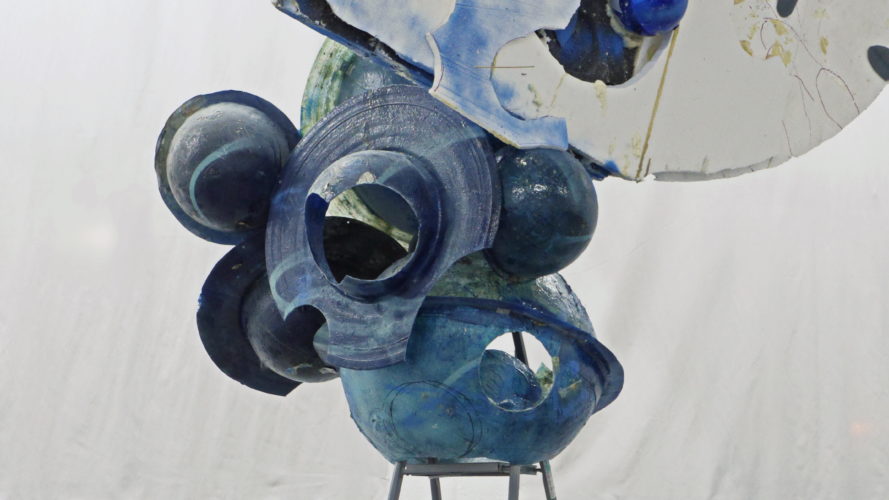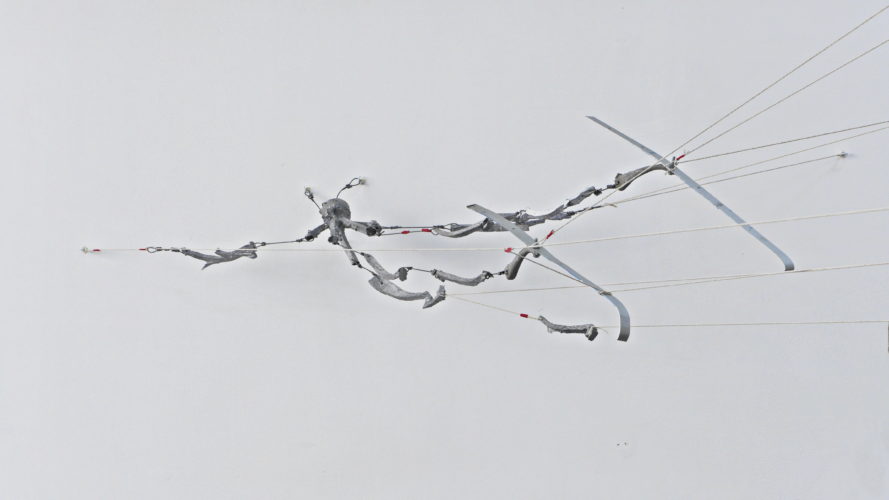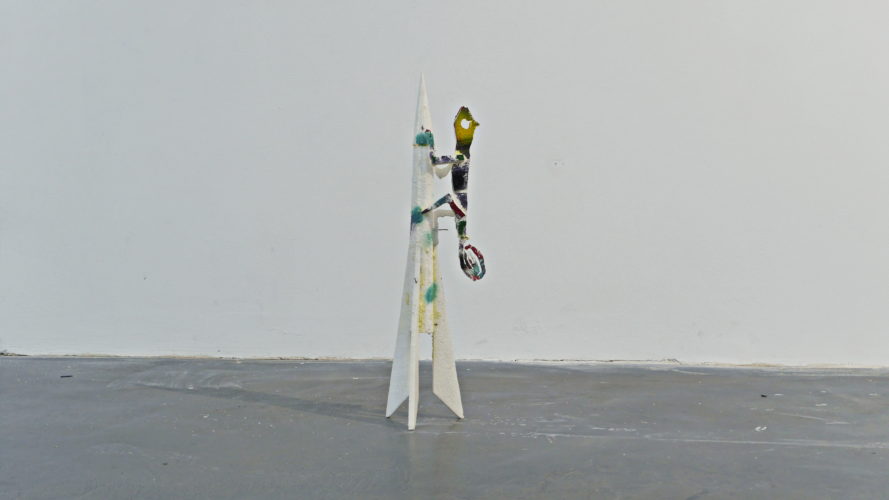Cristian Răduţă’s exhibition Anatomy of a Journey at ElectroPutere Gallery presents a group of installations that manifests two lines of signification: an imagined re-enactment of space explorations, but also a proof of the necessary role of chance in scientific progress. From a narrative viewpoint the exhibition is a “remake” similar to those found in Natural Museums presenting post-factum objects that re-establishes our cosmic odyssey: a castaway astronaut; a rocket carrying a chameleon; a ladder that holds a system of compacted planets intersected by a chart of the Universe; the wing of an airplane with a propeller engine; an orb wearing a beanie; another that has some eyeglasses stuck to it; an anchored parachute; a tridimensional map of a region of the Universe; an eviscerated planet; a geographic globe reduced to an apple stub. The viewer is entrusted with the deciphering of a visual syntax whose complexity declines inoculated cognitive norms. Cristian Răduţă describes an ironic journey of knowledge and human hope exploiting our cultural imaginary framework that has become in this century totally “scientific”. He also creates a distancing effect allowing a historic delay in order to seize the relation between standard representations and the scientific theories about the universe.
As scientific discourse has become the sole interpretation of reality, admitted mostly due to its technological innovation and the promise of a future salvation (from war, natural calamities, alien invasion, and the annihilation of the ecosystem), its discourse is supplemented under the imperatives of cultural entertainment with extra-terrestrial mythologies and utopias. How can one artistically “narrate” the popularized scientific imaginary that gives now a common sense of the cosmos (astronauts, satellites, planets, high resolution pictures with parts of the Universe, S.F movies and so on)? How can one expose such common logic of evaluation of the Universe? What else can we understand from the eschatology of the colonization of Mars?
I think that one can find in the works of Cristian Răduţă a sort of sensibility proper to abstract expressionism (David Smith / Robert Rauschenberg) that ends in pop-art. The sometimes monumental assemblages are made of wood, metal, plastic, textile, aluminium and polystyrene. The bricolage of these materials are made so as to display the tension between their friable structure and alleged utility.
The chromatic display is set by the nature of the materials, with subtle and punctual interventions that provides a surplus of referentiality (the colours used resemble the NASA photos). In the same manner, one can observe recurrences of red in the construction of the assemblages (the eyeglasses, the anchors of the parachute, the castaway astronaut, the orb wearing a beanie, the propeller engine) that signal an itinerary for our gaze / understanding or maybe simply balances the composition.
The most relevant aspect is the process of assemblage, i.e the solutions of binding the components together. Clips, ropes, insulating tape, nails, reinforcements or wire links are not just playful accents or the expression of a sought-after fragility. The installations operate with ad hoc gripping systems that ironically mark the arbitrary and originary aspect of domestic inventiveness, a legitimate precursor of the technology industry. From an aesthetic point of view, these elements confer a sculptural unity. Cristian Răduţă highlights a cultural process of the understanding of the Universe, and does not seek to denounce the massification of images, a contemporary phenomenon that affects the artistic process and leads to the erasure of the difference between the art and consumption objects. Thus, the viewer can follow the development of a game strategy through the montage of the “connectors” (pins, wire, rope, insulating band) or by the use of garments (gloves, hat, textile strips) that compromise the objectivity of the visual statements questioning the repertoire of our standardized imaginary.
Instead of a conclusion, I propose a fragment that best hints at Cristian Răduţă’s “attempt”, the first phrase from the prologue of Hannah Arendt’s book entitled Human Condition: “In 1957, an earth-born and man-made object was launched into the universe, where for some weeks it circled the earth according to the same laws of gravitation that rotate and keep the celestial bodies in motion — the sun, the moon, and the stars. Certainly, the man-made satellite was no moon or star, no heavenly body which could follow its circling path for a time span that to us mortals, bound by earthly time, lasts from eternity to eternity. Yet, for a time, it managed to stay in the skies; it dwelt and moved in the proximity of the heavenly bodies as though it had been admitted tentatively to their sublime company.”
The Anatomy of a Journey, solo exhibition of Cristian Răduţă, was between 7 April – 7 May 2017 at Galeria ElectroPutere, Craiova.
POSTED BY
Emilian Mărgărit
Emilian Mărgărit is an independent curator and since 2017 founding member of Image and Sound, Bucharest. He has a PhD in Philosophy (contemporary French Philosophy), he has published in collective v...























Comments are closed here.